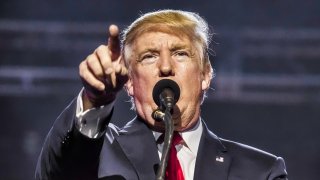Isolationism 2.0: Donald Trump and the Future of the Liberal Order
Donald Trump recently disparaged NATO and joked about future Russian aggression, increasing doubts around the world about the future of American foreign policy. With isolationism and protectionism rising and revisionist powers challenging a Western-dominated international order, many hear echoes of the 1930s.
Donald Trump recently disparaged NATO and joked about future Russian aggression, increasing doubts around the world about the future of American foreign policy. With isolationism and protectionism rising and revisionist powers challenging a Western-dominated international order, many hear echoes of the 1930s. Fighting has already erupted in multiple regions, and as the political scientist Hal Brands notes, “the world could be as little as one mishandled crisis away from pervasive Eurasian conflict.”
Thankfully, the odds of another world war are tiny, because nobody has an interest in fighting it. In the eight decades since the last great power struggle ended, nuclear weapons have increased the cost of conflict, globalization has increased the benefits of cooperation, and dictatorships have become less extreme. Putin is not Stalin, Xi is not Mao, and neither of them is Hitler. So even if regional conflicts like those in Ukraine and Gaza fester, there is every reason to believe the long peace at the top of the international system will continue to hold.
Where the 1930s analogy does work well, however, is in the domestic politics of American foreign policy. Back then, military disappointments produced a powerful isolationist movement that hobbled the country’s foreign policy and prevented Washington from responding effectively to an increasingly challenging international environment. That same pattern is repeating itself now. The real danger to be worried about today is not foreign aggression escalating into World War III. It is the continued decay of the liberal international order thanks to home-grown American fecklessness.
The First America First
American entry into World War I represented a dramatic change from the country’s traditional approach to foreign policy. To justify it, President Woodrow Wilson cast the conflict as a noble crusade to defeat evil aggressors and make the world safe for democracy. But as the postwar era failed to live up to expectations, many Americans developed a strong case of buyer’s remorse. In retrospect, they came to see participation in the war as a giant mistake—one so obviously misguided, in fact, that it must have been driven by some nefarious conspiracy. Arms manufacturers had pushed the country into war for the profits to be made, people said. Bankers had done it to protect their loans to the Allies. The lesson seemed obvious: never let the country be suckered into foreign intervention again.
As storm clouds gathered across Europe and Asia during the 1930s, therefore, isolationists in Congress passed a series of laws barring American help to any nation fighting anywhere. The Neutrality Acts of 1935, 1936, and 1937 banned arms sales and loans to all foreign belligerents, prohibited travel by Americans on belligerent ships, and forbade the entry of American ships into foreign war zones. The idea was to create a geopolitical firebreak against the spread of war—so that even if the rest of the world burned down, at least the Western hemisphere would remain safe.
As international order continued to disintegrate, the world’s strongest power sat on the sidelines. Washington watched Japan invade China, Italy invade Ethiopia, and Nazi Germany threaten Europe, and did nothing. President Franklin Roosevelt was no fan of intervention himself, but he grudgingly came to realize that isolating the United States from Europe and Asia was only increasing the risk of a general war while hindering American preparedness for it. He tried to persuade Congress and the public to allow him greater policy flexibility to help friendly nations in danger, but to no avail. Only after the Nazi and Soviet invasion of Poland in 1939 did the constraints begin to loosen, and even then, not by much. In 1940, hard-core isolationists banded together in the America First Committee, and it took the Japanese attack on Pearl Harbor in late 1941 to make their voices go silent.
Once in the war, Roosevelt sought to defeat the Axis and achieve a more modest version of Wilson’s liberal vision. He thought it would be possible for the victors to maintain harmony and prosperity through a combination of democratic peace, great-power concert, multilateral cooperation, and free trade. And he created a wave of new institutions to carry out his plan, including the United Nations, the World Bank, and the World Trade Organization.
But once again, however, the postwar era failed to live up to its billing. Britain turned out to be much weaker than expected; Europe, more devastated; and the Soviet Union, more truculent. After two years of drift, the Truman administration decided to shift course. Alongside FDR’s grand universal framework for global governance, it set up an American sphere of influence run along liberal lines, supplementing the UN and Bretton Woods institutions with the Truman Doctrine, the Marshall Plan, and NATO.
The administration sold this new course, along with a permanent American military presence abroad to enforce it, to the public as a response to the increasing Soviet threat, and in some ways it was. But the threat being countered was not to the U.S. homeland. It was to the new, broader international order American policymakers had already decided to build, one in which a community of nations would cooperate and trade peacefully with one another under Washington’s guidance and protection. During the Cold War, this system developed and deepened in the West. After the collapse of the Soviet Union, it spread to the rest. And by the 21st century, it reached almost everywhere.
In practice, the postwar order consists of a dense web of voluntary interactions and institutions designed to enmesh countries and guide them to security, prosperity, and liberalization. Over its eight decades of existence, it has worked well in some ways and less well in others. It has not served everybody equally nor lived up to its own boasts or aspirations. But on balance, it has produced astonishing peace, growth, and human flourishing—more so on all counts than any other period in history.
The New Isolationism
It was easier to defend the order at the turn of the millennium, when American power was at its peak and its hegemony was generally welcomed or at least accepted. A series of military misadventures and economic problems in the new century, however, tarnished Washington’s reputation for wisdom, morality, and competence. Eventually rising powers such as Russia and China challenged American leadership abroad, while populists at home demanded protectionism and retrenchment. Once again, popular dissatisfaction with the results of an active, global foreign policy have spurred buyer’s remorse, bitter recrimination, and conspiracy theories. Nefarious elites lied the country into unnecessary wars in Iraq and Afghanistan, people say; they got rich from trade with China at the cost of other people’s jobs. Donald Trump rode this wave of anger and frustration to power in 2016, and since then has vigorously preached the old-time isolationist religion.
The postwar order was based on one basic insight policymakers drew from the failures of the interwar years: In the modern world, foreign policy was a team sport, not an individual one. As a dying Roosevelt explained in his Fourth Inaugural:
"We have learned that we cannot live alone, at peace; that our own well-being is dependent on the well-being of other nations far away. We have learned that we must live as men, not as ostriches, nor as dogs in the manger. We have learned to be citizens of the world, members of the human community. We have learned the simple truth, as Emmerson said, that “The only way to have a friend is to be one.”
Roosevelt and Truman actually believed that, and infused enough of it into their behavior, and into the system they created, that other countries were glad to join the effort. In return for joining the team, they got not just protection but membership in a shared collective enterprise, the development of a stabler, richer, more open world. Over the decades since, the United States has not always lived up to its own ideals or abided by its own rules. But it has remained remarkably devoted to the general project. Until now, that is.
In contrast to all other presidents since 1945, Trump rejects the postwar order’s basic assumptions. He believes in protectionism rather than free trade, competition rather than cooperation, and authoritarianism rather than democracy. Trump has no appetite for positive-sum games because he lives in a zero-sum world. He resurrected the old America First label for his foreign policy because he agrees with its ideology. For him, the United States has no real connection to the world beyond its borders; everything is cash and carry.
Ukraine’s Finest Hour
Trump’s first term in office was something of an accident. Neither he nor anybody else expected him to win, and no real preparations had been made for what to do if that happened. Once in the White House, Trump displayed various isolationist tendencies, but their impact was kept in check by inattention, inertia, and resistance from professional staff. When Trump left office in disgrace, his successor returned American foreign policy to something resembling its previous course, and it seemed that the danger of an isolationist America had largely passed.


